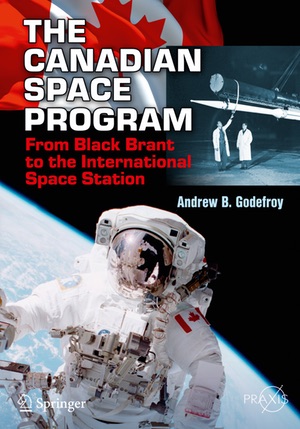Review: The Canadian Space Programby Jeff Foust
|
| In the early 1960s, Canada was largely self-sufficient in space, with the exception of the ability to launch its own satellites. |
That space strategy is the latest effort by the Canadian government to define what space means to the country. While the government and Canadian companies have made significant accomplishments in space over the decades, including the robotic arms for the shuttle and International Space Station, as well as the Radarsat series of synthetic aperture radar satellites, the country has overall been a minor player compared to countries like Europe and Japan, let alone the US and Russia. A new book, The Canadian Space Program, traces the history of Canadian space efforts from before Sputnik to near the present day.
Canada’s initial forays into space were linked to ionospheric studies by Canadian researchers dating back to World War II, when that work was key to predicting radio propagation. Rocketry projects, supported by the Defence Research Board, led to the development of sounding rockets, including the Black Brant family of rockets. That interest in ionospheric studies led to Canada’s first satellite, Alouette 1, launched in 1962 by NASA. In the early 1960s, author Andrew Godefroy notes in the book, Canada was largely self-sufficient in space, with the exception of the ability to launch its own satellites.
There was, however, little organizational structure to those space efforts. “The continued absence of clear senior-level political direction or motives for its space program meant that Canada’s early space advocates were largely left to their own devices in promulgating national interests, research, and development during most of the 1960s,” Godefroy writes. The government eventually came up with a space strategy in the 1970s, along with an interagency committee to oversee space projects, but they were not centralized into a space agency until 1989.
During this time there was also a shift in focus from experimental and scientific projects to more practical applications, like communications and remote sensing. Canada, though, also sought a role in American human spaceflight programs, something less practical, perhaps than communications satellites but which had a higher profile with the public. Canada’s development of the shuttle’s robotic arm came after Canadian engineers notes that early concepts of the shuttle included “a crane of sorts” that was missing from later proposals from aerospace companies. That led to a robotic arm, based on technologies for a system for refueling nuclear reactors, that became the famous Canadarm and Canada’s entrée to human spaceflight.
| “With very limited resources Canada’s space program not only survived decade after decade, it prospered as a constant example of national achievement,” Godefroy writes. |
Much of the latter part of the book focuses on the Canadian astronaut program, including the selection of various astronauts and the shuttle and ISS flights they made. There is less discussion of satellite programs and policy issues than in the first part of the book. Despite being published this year, the book largely concludes in 2009, with only a brief mention in the conclusion of events like Chris Hadfield’s ISS expedition in 2012–2013 and the selection of new astronauts. There’s also less about the state of Canada’s space business, such as the rise of Telesat—established as a Crown corporation to operate Canada’s early communications satellites—into a major global satellite company, or the growth of MacDonald, Dettwiler and Associates (MDA) in satellites and space robotics.
Godefroy, in the book’s conclusion, is proud of what Canada has achieved in space to date. “With very limited resources Canada’s space program not only survived decade after decade, it prospered as a constant example of national achievement,” he writes. As Canada contemplates its future direction in space, his book concludes that the country should not take space for granted. “It is a legacy of which the country may be justly proud but, more importantly, it must continue to be supported if it is to remain a part of the national identity and agenda.”
